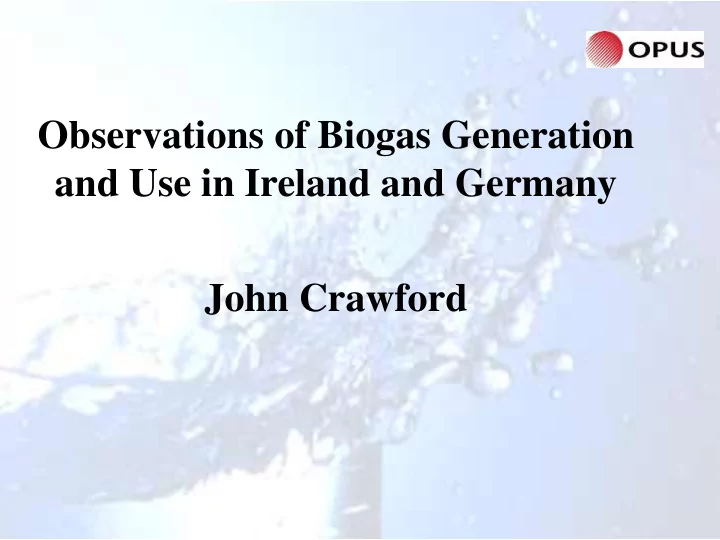

Observations of Biogas Generation and Use in Ireland and Germany John Crawford
Agenda • Practice • Introduction • Engineering • Drivers • Conclusions • Energy Context
Introduction • Increasing Interest for Dairy AD in NZ • Increasing herd size • Increasing interest in housing • Increasing problems with effluent disposal • Appears to be popular and successful in Europe – • Why? • Can we emulate that? • What drivers? • Scale – Also an interest for NZ municipals
Drivers • Farm Waste Stream Management • EU Directive • Profit
Drivers: Farm Waste Management • This is almost certainly the starting point for most of the farm based AD systems: • Desire for improved sustainability of the farming operation • Availability of nutrients • Transportability of nutrients • Odour management • Quantity of slurry
Drivers: EU Directive & Profit • EU Directive 2009/23/EC • Requires member states to achieve 20% renewable electricity generation by year 2020 • Incentives introduced to actively encourage investment • Each State has its Own Incentives (or not) • Profit • Replacement of Retail energy. • Sale of energy. • Provision of heat energy to additional farm revenue enterprises. Gate fees • Fertilizer savings
Energy Context • Historically low levels of electricity generation by renewable energy sources. • Approach to incentives varies • FIT and ROC or FIT • Seem to be available till 20% target is reached. Then made difficult or cut altogether. • Typically assured payments for 20 years • Grid operator must accept the energy – legislated – but doesn’t have to make it easy.
Energy Context • Northern Ireland (UK 184 units, increasing) • ROC = £43.30 • 4 ROCs per MW.hr = £0.1732 / kW.hr, plus • Feed in Tariff = £0.05 / kW.hr, plus heat use incentive • Germany (8,000 units, static) • Sliding scale of € ct6 to € ct14 / kW.hr, plus • Various premium payments (size, feedstock, flexibility • Maximum € ct25 / kW.hr • Householder pays € ct20 + € ct6.5 /kW.hr as ‘Green energy support.
Energy Context - Example • Northern Ireland • CAPEX £1.8M • 500 kWel, 91% overall availability • 400 cow herd, 6,500t @ 6%DS cattle slurry Annual Cost Annual Revenue Feedstock, 12,000t @ £50 £600k 500x91%x24x365x£(0.173+0.05) £889k Maintenance £60k Digestate Savings on Fertilizer £20k Labour & Admin £40k Gate Fees for waste acceptance £0 Depreciation or CR @5% £90k Dried Wood Chip Revenue £ ?? Interest @4% £72k Total Annual Cost £862k Total Annual Revenue £909k ++
Practice • Robust, well engineered systems. • Trend is 250kW.el minimum economic and increments of 250kW.el. Some go lower, BUT … . • Cattle / Pig slurry used as the biological inoculum and a low grade energy source. • Alternative feedstocks (On & Off farm) provide the bulk of the energy yield: • Grass & Maize silage • Winter wheat • Beets • Chicken litter • Food & meat wastes (must be pasteurized)
Engineering • Concrete or SS reactors • Three styles of Gas storage: • Double skin, pressurized bladder over headspace • Double skin, pressurized external balloon • Pressurized headspace under concrete roof • Common engines: • MVM Gas – Owned by Caterpillar • Jenbacher • Deutz • Scania • Leihberr
Engineering • Mixing styles the key difference: • Submersible WW mixers (Williams) • External Recirculation & jets • Gas Mixing (Greenfinch) • Inclined shaft / Big blade (Weltec) • Mississippi Paddle Wheel (Hochreiter) • Common themes: • CHP • Stainless steel pipework • Centralised pumping and maceration • Instruments: Temp, Pressure, Gas analysis, Titration analyser. (Adequate, not excessive) • Digester treated like another herd of cows
On the Farm • An extra FTE staff member to manage the digester: • Loading the feeder • Monitoring operation • Managing digestate • Legislative and Revenue administration, • Depending on feedstock, AD process measured as increasing N bioavailability by 18 – 24% over that of the feedstock. • Odour level from digestate is about 1/10 th that of raw animal slurry. • AD reduces the mass for disposal ~21%
Conclusions • Digester treated like another herd of cows. • Economics of an electricity only enterprise questionable without the incentives. • Economics of a slurry only enterprise questionable. • Multiple Feedstock – Multiple Product – Better Outcome • Other revenue streams and farm operational drivers are the key to financial viability. • Small scale systems displacing retail energy purchase, using the heat and improving the feedstock fertilizer value may be feasible. Assessment each on its own merits. • In Feasibility study – look for a ‘Sweet Spot’ where the drivers overlap.
Conclusions • For current New Zealand context: • We don’t yet have year round housing of cows (pigs yes). • Collect approx. 10% of slurry. • No incentives and low wholesale feed in tariffs. • Is wholesale electricity more valuable than milk produced from silage? • The digestate would be valuable. • Parallel, heat using enterprise may be the key as may upgrading biogas to methane and use as a biofuel. • Recommended Reading: • A Review of Anaerobic Digestion Plants on UK Farms, by Angela Bywater, for Royal Agricultural Society of England.
Acknowledgements • Noel Gavigan, Bioenergy Association of Ireland (RoI) • Dr Peter Frost, Agri-Food and Biosciences Institute, Hillsborough Research Farm (NI) • Nigel Moore, CAFRE, Greenmount Agricultural College • Williams Industrial Services (NI) • Edina (RoI) • Weltec Biopower (Germany) • Blackiston-Houston Estates (NI) • Progressive Energy (NI) • McDonnell Farms / GreenGas (RoI) • Weichering Sudmann (Germany) • Suren Meyer (Germany) • Naturstrom Buschheide (Germany)
Recommend
More recommend